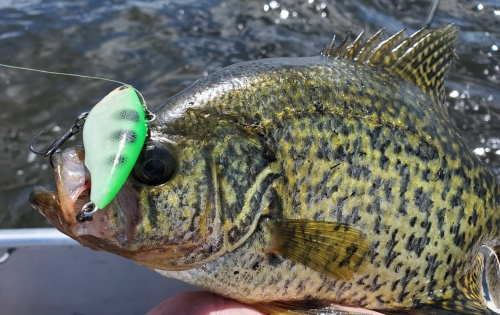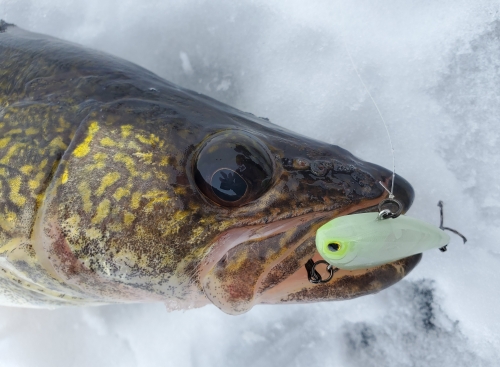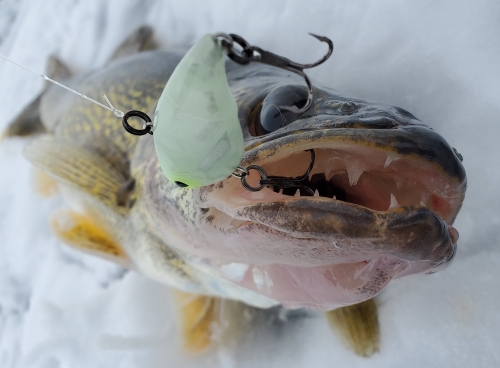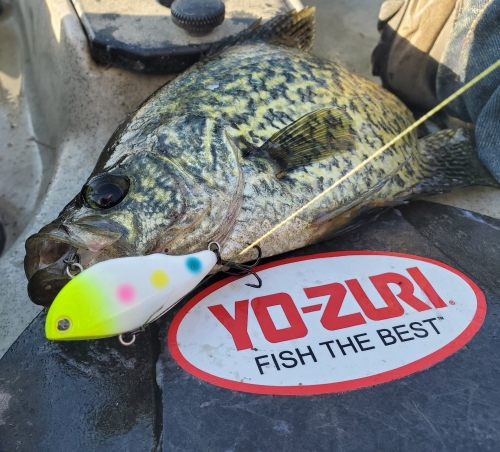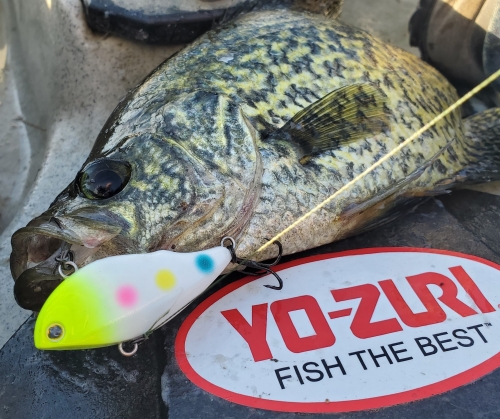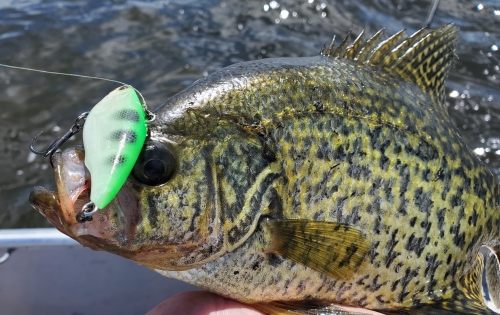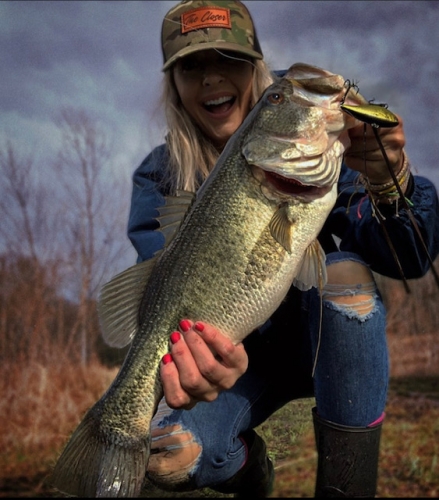BLOG
Northern Summer Time Multi-Species Jerk Bait Fishing Techniques
 As the water temps reach and maintain their peak in mid to late summer, many anglers switch their presentation to live bait offerings or plastics to catch walleyes, largemouth bass, and northern pike. While these presentations absolutely catch fish during the dog days of summer, do not put away those hardbaits just yet as the 3DB Jerkbait 110 Deep can entice all predator species from their haunts throughout the summer months.
As the water temps reach and maintain their peak in mid to late summer, many anglers switch their presentation to live bait offerings or plastics to catch walleyes, largemouth bass, and northern pike. While these presentations absolutely catch fish during the dog days of summer, do not put away those hardbaits just yet as the 3DB Jerkbait 110 Deep can entice all predator species from their haunts throughout the summer months.
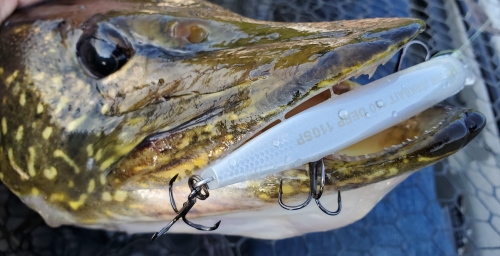
Lure: Yo-Zuri 3DB Jerkbait 110 Deep: At 4 3/8” and 1/2 oz., the Yo-Zuri 3DB Jerkbait 110 Deep can dive 8-12’ down in the water column. It is a superb choice for predator species as it is bigger than much of the young-of-the-year forage that is available in many bodies of water during the summer to late summer period. This is an important fact because the size difference the 110 Deep has from schools of 2-3” perch, for example, helps it stick out more and can lead to more hits when chasing walleyes, northern pike, or largemouth bass. The Yo-Zuri 3DB Jerkbait 110 Deep is great for use with long or short casts and its 3 treble hooks increase the percentage of hookups significantly once a fish bites.
Line: If you do not like using a leader when fishing, even when chasing northern pike over 30”, going with Yo-Zuri 20 lb Dark Green SuperBraid is an excellent option. This line is perfect when using the 3DB Jerkbait 110 Deep because its sensitivity allows for exceptional bite detection; it is abrasion resistant which is critical when fishing in and near weeds; and it can land fish well beyond the line test capacity listed on the spool.

Location: One of my favorite locations to fish for summer walleyes, northern pike, and largemouth bass is along and just inside weedlines in 8-12’ of water. This may sound shallow as a lot of fish move to deeper water when water temps reach 80 degrees, but the ones that stay in the densest weeds, are often the bigger and more aggressive fish which hunker down waiting for prey to pass in front of them. One of the keys to weedlines is to find more than one type of weed present. Cabbage mixed with grass, or even lily pads adjacent to grass or cabbage that are right at the first break into deeper water are prime spots. Once I have found these kinds of scenarios in a lake, regardless of the air or water temp or even time of day, I cast the 110 Deep parallel to the weedline and just inside the weedline to prompt strikes. If you are connecting with weeds every 3 or 4 casts, then you are casting where the bigger fish often lie in wait.
Retrieve/Cadence: When using the 3DB Jerkbait 110 Deep, I usually go with a qualitative and quantitative approach to the casts. When I cast it out, I wait for 3-5 seconds before beginning my retrieve. Then going with 1-4 twitches/jerks so that the lure moves 3-4’ forward and suspends is ideal. One wrinkle that I like to throw in the mix is to also crank the reel handle hard 1-4 times or gently pull the lure forward with 1 longer sweeping movement. Varying up the number of times the 110 Deep is moved as well as HOW it is moved can elicit some explosive strikes from any freshwater predator.
If you are looking for a “go-to” lure when chasing walleyes, northern pike, or largemouth bass around weedlines throughout the summer, then the Yo-Zuri 3DB Jerkbait 110 Deep is a top-notch choice to include in your gear box.
Tight lines and safe fishing!
Late Spring Topwater: Dustin Wilks

Topwater is the most fun of all fishing techniques. A bass eating a topwater with a sudden explosion is what it is all about. It is not only fun, it is also a great way to catch big fish.
In the late spring, a bunch of stuff is going on. There are bass still spawning, some guarding fry, some all done, and then there is the shad and blueback herring spawn. All of these scenarios are great for topwater making late April and all of May excellent for topwater.
Here I’ll briefly go through the ideal bait for each situation.

Spawning — The Hardcore Popper as a really tight walking action with tight twitches of the rod. It does not move very far forward on any given twitch. This makes bass on the bed really mad and explode on it. I’ve already caught some of my biggest bass this year on this bait. Remember to quickly release these bass, this is not the time to put them in the live well and show them off to your buddies, they need to lay those eggs.
Guarding Fry — Most of the time it is just the male bass still guarding the babies after they hatch, but every once in a while both bass will guard them or a large male. My favorite here is the Yo-Zuri 3DB Prop. This bait rips the surface looking like a something that is eating those fry — it drives them crazy and they eat it. Poppers work here too.
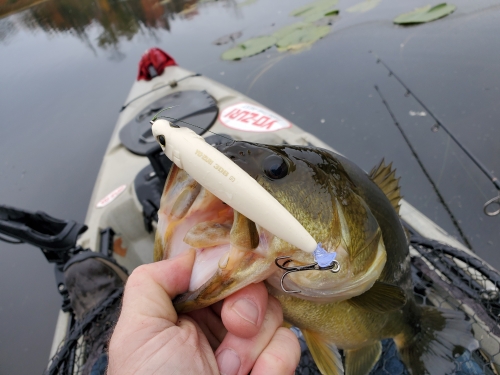
Feeding bass — The Yo-Zuri 3DB Popper. It has an extended body at 3″— a little longer than most poppers and has a nice fast walking action or you can just pop it along. I like to walk it, for fish outside of spawning pockets, typically on the first adjacent point or heavier cover is where you will find them when they first leave the nest.
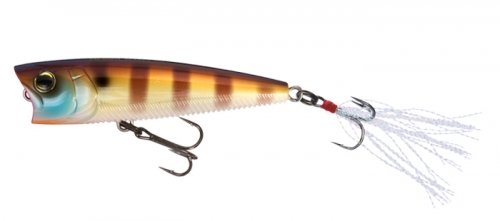
The Shad Spawn — This is where the traditional walking baits are best. The Yo-Zuri 3DB Pencil in both 4 and 5 inch. The standard Pencil is my favorite for the shad spawn because Shad are not as fast as Blueback herring. Fish this bait early in the morning on rocky banks or clay banks, beside bushes, or floating docks and Marina’s. This does not last long, so be on the water early. I like the 5’’ when I’m specifically looking for bigger fish. The 4’’ Pencil is my most consistent topwater bait in my box. I like Bone or shad colors in this situation. If the water is really clear, some of the new colors like gizzard shad are exceptional at tricking the bass.
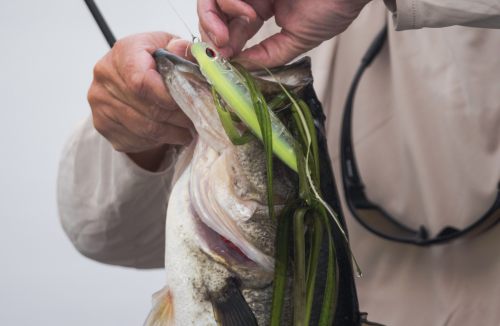
The Blueback Spawn. In many lakes in the Southeast U.S., Blueback herring are the dominant prey and bass have a distinct craving for these apparently tasty treats. Bluebacks are notorious for spawning on very shallow points and shoals. Long casts are often key. The Yo-Zuri 3DB Pencil Popper gets the nod here, though I mix it up with 4’’ Pencil and a soft jerk bait. The key to the Pencil Popper is it casts like a bullet, any schooling action can be met with a precise cast and a bait that not only looks natural, but has a really quick walking action. Bluebacks swim faster than shad, so use a faster retrieve.
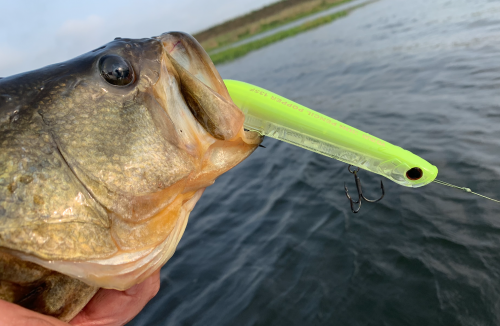
This Spring, get geared up with these great baits for some serious topwater fun!
Multi-Species, Multi-Seasonal Hardbaits for 2021: Mark Maule
Living in the Ice Belt can pose a series of seasonal fishing challenges. Drastic temperature changes and high and dirty water are expected from the spring through the fall season. When the snow flies and ice forms, it is without question that we will see ice up to 3’ (or more) thick and actual temps down to -40. Having a host of multi-species, multi-seasonal lures can be what keeps you on fish during the most challenging of conditions, and Yo-Zuri has got it covered. Here are some of my recommendations for the upcoming 2021 kayak and ice fishing seasons.
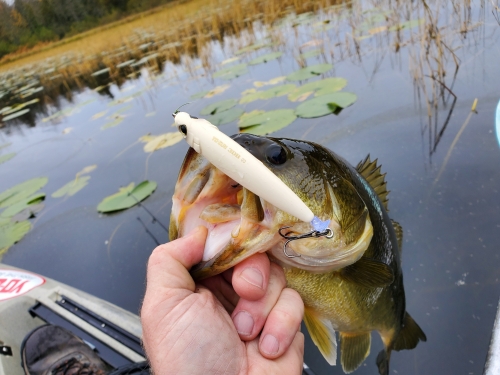
3DB Props
The 3DB Prop will be a must have lure for me in 2021 from spring to fall as it helped me win the 2020 AOY kayak championship tournament as well as the AOY overall for my region in the tournament series in which I took part. It is a multi-species lure in that it can produce everything from largemouth and smallmouth bass, northern pike, and even muskies. The Bone and Prism Frog pattern Props are probably the most universal colors that I throw in that they can be effective in every weather and water conditions imaginable and catch fish. Other great pattern options include the Prism Gold Black and Prism Silver Black for tannic or dark-stained waters and Prism Clown or Prism Ayu for clear waters on sunny days. The key when chasing any predators with 3DB Props is listening and watching for dragonflies. The plastic prop included in the design of the lure shows Yo-Zuri’s innovative technology in its hardbaits because of how it simulates a dragonfly flapping its wings on the surface…vary the cadence with 1 to 4 cranks of the reel handle and the fish simply cannot refuse!
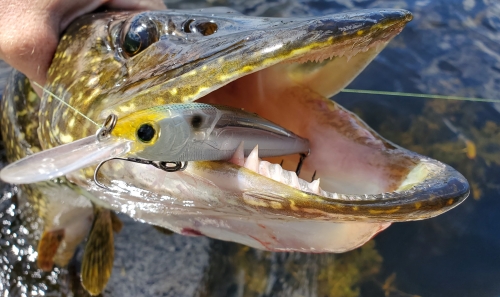
3DB Jerkbait 110 and 3DB Jerkbait 110 Deep
Every single trip I make in my kayak in 2021 will include the Yo-Zuri 3DB Jerkbait and 3DB Jerkbait 110 deep as they were responsible for helping me land my biggest northern pike and biggest largemouth bass of the entire 2020 kayak season. The 3DB Jerkbait 110 and 110 Deep are another exceptional multi-species, multi-seasonal lure series as they regularly can bring in northern pike, largemouth and smallmouth bass, and walleyes from the time the ice melts in spring until the first ice forms in late fall. The Ghost Sexy Shad, Natural Tennessee Shad, and Natural Ayu are all solid patterns whether fishing in clear or stained water for any of the mentioned fish species due to their long build, realistic patterning, and the ability to work the 110’s to 4’ down and 110 Deeps to 12’ down in the water column.
Rattl’N Vibe Mini
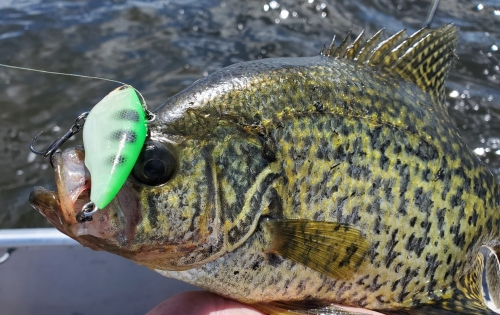
The Yo-Zuri Rattl’N Vibe Mini will be in my gear boxes on every kayak trip I take in 2021 as it was responsible for helping me land my biggest walleye EVER in my kayak in 2020. It is arguable that the Mini is the most versatile multi-species lure I use because I have caught everything from 4” perch to northern pike over 30” on it. The Rattl’N Vibe Mini’s versatility not only is demonstrated with the number of species that can be caught, but it can be used year-round in open water and on ice. Some of my favorite patterns are the new Luminescents because of how they glow, the UV Tigers (Purple, Pink, and Blue) because of their visibility in the water column, and Gold Black and Silver Black because of their metallic finishes. All of these patterns work great in tannic or clear water throughout the kayak season or in winter when light penetration is limited below the ice.
If you are looking for some solid multi-species, multi-seasonal hardbaits to get the most bang for your buck on your next open water or ice adventure in 2021, then look no further than the Yo-Zuri 3DB Prop, Yo-Zuri 3DB Jerkbait 110 and 110 Deep, and Yo-Zuri Rattl’N Vibe Mini.
Good luck, be safe, and tight lines in 2021!
Rattl’N Vibe- my all time favorite lure
If you told me I was going to be stranded in a remote area with only two lures to catch fish, I would without a doubt choose the Yo-Zuri Rattl’N Vibe in Matte Craw and Golden Shiner. These two have performed for me in almost every condition- and across a variety of lakes and ponds. The 3/4 oz is my absolute favorite size (although I have caught tons of fish on the 5/8 as well) There’s something special about this lure!
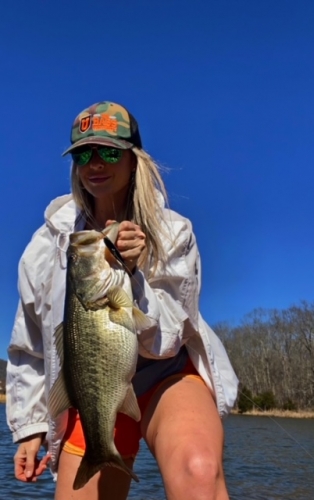
You can fish this lure with so much versatility too. Burn it through the water, rip it through grass, yo yo it off the bottom or even a slow and steady retrieve. It covers water quickly and is a fantastic choice for when you are fishing a new spot. It will do the work for you. I’ll send it out and pop it a few times and the weight distribution of the lure itself resembles a dying baitfish. The Golden Shiner even flashes like bait fish do. It really is fun to fish the Vibe!
I have shared this lure with beginner Anglers and even a few seasoned ones and they all sing its praises. With so many color options, sizes and it’s ease of use, I recommend keeping them stocked up in your tackle box.
There’s nothing quite like a big bass breaking the water, shaking its head back & forth and you hearing that rattle hooked up in its mouth.
Big or small, this lure catches them all!
Micro Lines for Macro Midwinter Panfish
Depending on your location in the Ice Belt, midwinter fishing patterns can start sometime around the second or third week of January and run well into March. Midwinter often means thick ice on lakes, deep snow decreasing light penetration to the depths below, and a host of panfish that just as easily sniff and swim by a less natural-looking bait than eat it. Yo-Zuri has come out with two ice lines that can help combat the negative moods panfish are in during the midwinter ice period and turn finicky fish into fish that bite…the Yo-Zuri 1 lb. test TopKnot Ice Super Fluorocarbon and Yo-Zuri 1 lb. test Ice Hybrid.
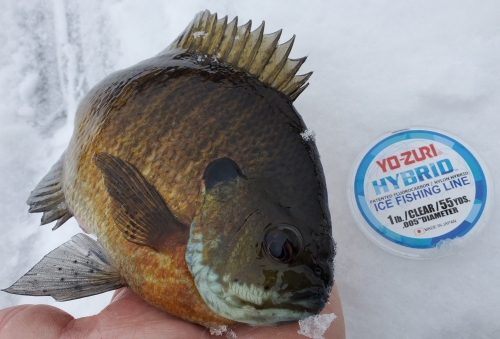
Yo-Zuri 1 lb. Test TopKnot Ice Super Fluorocarbon
The Ice Super Fluoro is extremely sensitive and it has an exceptionally thin diameter (.005”). It is the perfect line when chasing big bluegills from deep weedlines to basins in 20’ of water or more because these fish are notorious during midwinter for hitting and spitting a bait faster than an angler can blink. The super sensitivity the Yo-Zuri 1 lb. test TopKnot Ice Super Fluoro allows anglers to detect even the slightest of bites, which of course can lead to higher percentages of hookups.
Another feature of the Ice Super Fluorocarbon that really makes this a special ice line is that it is abrasion resistant. Pound for pound, big bluegills are renown for their fighting prowess. When they swim in circles at or near the bottom of the ice hole, having an abrasion resistant line like the 1 lb. test Ice Super Fluoro can oftentimes be the difference between landing these brutes and losing them.
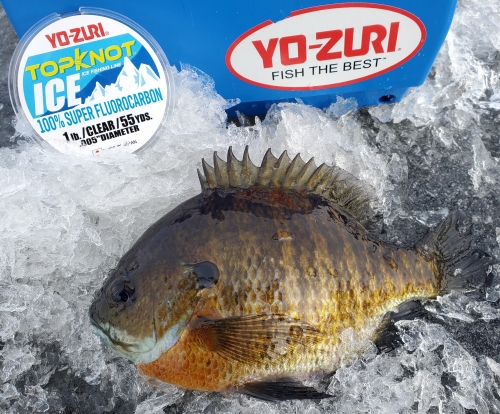
Yo-Zuri 1 lb. Test Hybrid Ice Line
Similar to the 1 lb. test Ice Super Fluoro, the 1 lb. test Hybrid Ice Line has an incredibly thing diameter at .005” and is highly sensitive. One important difference is that it has a little more give when it comes to stretch, so this will be a line that I will use when I am after slab crappies roaming 25’ down in 40’ basins. The little extra stretch that the 1 lb. test Hybrid Ice Line offers can help with getting a softer hookset as is often needed with big crappies. In addition to big crappies, the 1 lb. test Hybrid Ice Line can be loaded with lures up to 1/16 oz. for jumbo perch in everywhere from 10-20’ of water over flats containing gravel and sand or long points jutting out into a lake.
Do not let the more challenging midwinter bites get the best of you! Going with the Yo-Zuri 1 lb. test TopKnot Super Fluorocarbon or Hybrid Ice Lines allow for natural presentations with durability and sensitivity needed for big panfish. It is time to go micro with your lines for macro midwinter panfish!
Tight lines and stay safe!
Hard-To-Beat Hardbaits For Early Ice Panfish

While there are a multitude of different ways to catch panfish on early ice, few methods can compare to using mini hardbaits. The Yo-Zuri Rattl’N Vibe Mini is a great example of a mini hardbait that can lead to fast and furious action with explosive strikes from some of the largest panfish in a given body of water. Large crappies, perch, and bluegills strike the Mini with the veracity of apex predators.
The Lure:
At 1 5/8” and 3/16 oz., the Rattl’N Vibe Mini is a perfect size hardwater panfish lure as it is a little bit bigger than the average crappie minnow, but a little bit smaller than the average fathead minnow. This in-between size makes the Mini an ideal lure choice for enticing some of the bigger fish which may be hesitant to bite out of a respective school.
The numerous color schemes that the Rattl’N Vibe Mini comes in makes it an exceptional choice on any body of water as the variety virtually covers any situation that may be encountered. For example, the metallic patterns (Blue Chrome, Gold Black, and Black Silver) work perfectly for tannic-stained water due to the amount of light and flash that they reflect when jigged. Green Perch, Hot Perch, and Matte Crawfish Minis are all solid choices for clear bodies of water with high visibility due to the naturalistic appearance they have to prey panfish feed upon. Lastly, the Luminescent, Luminescent Perch, and UV Tiger patterns are all great selections during low light periods at the beginning and end of the day due to their glow and UV presence.
The Line:
The new Yo-Zuri ice lines are strong beyond their pound test listed, they are abrasion resistant when fish go on runs and rub the line on the bottom of the ice, and they have a very thin diameter which is paramount for increased sensitivity to feeling the bite. As a general rule of thumb the new Yo-Zuri TopKnot Fluorocarbon or Hybrid Ice lines in 3lb or 4lb test are good bets when using the Mini for panfish at early ice. The 3lb or 4lb test of either line allows for the Rattl’N Vibe Mini to be fished effectively with varied cadences to prompt the rattles within to click, but they also are strong enough lines to hold bass or northern pike when hooked as these predators are often found in the same vicinity as large panfish.
If an early ice fishing trip is on the docket, then stocking up on a variety of Yo-Zuri Rattl’N Vibe Minis and new ice lines is highly recommended to improve your odds of landing some great bull bluegills, slab crappies, and jumbo perch.
Good luck, tight lines, and stay safe!
In Search of a Sleeper
By: Steve Wayne
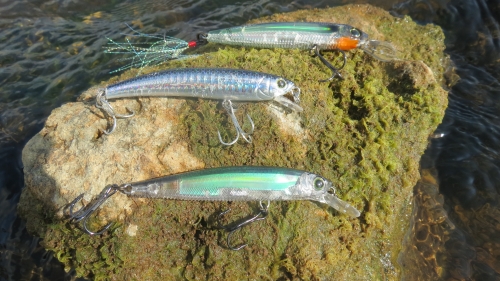
The retention pond was teaming with life! I stared down into the clear water and watched as a giant tilapia and a small 1 lb. bass swam lazily by my vantage point. A school of finger mullet darted nervously past the wary bass which indicated that the retention pond was in some way connected to the nearby Indian River Lagoon in Brevard County. I was targeting largemouth bass but welcomed any of the various species of brackish water fish such as snook, tarpon or redfish that might inhabit the pond. My bait of choice for this adventure was a Yo-Zuri 3D Jerkbait, a lure that would likely catch any type of predator fish that swam in either freshwater or salt. I surveyed the pond and spotted my intended target, a large grass bed that formed a point at the mouth of a nearby ditch that emptied into the retention pond. I casted the Yo-Zuri 3D Jerkbit well past the grassy point and slowly retrieved the bait along with the direction of a slight current coming out of the ditch. As the bait neared the point I watched as an attacking fish swirled at my bait! I instantly felt a hit and then set the hook on a decent size fish. The fish surged to the left easily taking drag. After a short battle I stared down into the clear water trying to decipher what was on the end of my line. The olive brown fish looked like a cross between snakehead and some type of goby. As I dragged the fish up the muddy bank, I realized that I had caught a rare catch, a bigmouth sleeper!
Bigmouth sleepers, Gobiomorus dormitor are a torpedo shaped fish with dull coloration that can vary from a light or dark brown to olive. They have a short broad head with a blunt snout. This species of fish has a large cavernous mouth-hence the name “Bigmouth” and can often swallow surprisingly large prey. The bigmouth sleeper has 2 dorsal fins as well as a broad and round caudal fin. According Florida Fish and Wildlife Conservation Commission’s (FWC) Research Administrator, Dr. Richard Paperno, bigmouth sleepers vary in length and can grow to almost 3 feet. They are found in rivers and bays on the Atlantic coast normally south of Melbourne. They inhabit the Sebastian River, St. Lucie River, Loxahatchee River as well as other brackish water canals and creeks in central and south Florida. Dr. Paperno advises that bigmouth sleepers are not abundant north of the Sebastian River, however the FWC has occasionally collected several samplings from as far north as the Jacksonville area. “Bigmouth sleepers do occur elsewhere in Florida, just not in very great numbers. They are in a group of fishes collectively referred to as tropical peripherals. Their center of abundance occurs in more tropical areas south of Florida, but they have managed to get a foothold in Florida, existing on the periphery of their normal habitat range” advises FWC’s Dr. Paperno. In addition to Florida, bigmouth sleepers are commonly found in the Mississippi River and along the rivers and bays of coastal Texas.
Bigmouth Sleepers spend most of their time in freshwater and are believed to travel to the brackish estuaries or marine waters to spawn. After spawning the juveniles move back into the freshwater tributaries. In some places where they have been trapped in freshwater due to development, they have been able to adapt and complete their entire life cycle in freshwater. Bigmouth sleepers are predator fish and feed on smaller fish, shrimp and crustaceans. The bigmouth sleeper lies on the bottom with slow moving currents to blend in to the bottom with its sluggish behavior and dull coloration. Brevard County angler, Gil Tompkins regularly catches big mouth sleepers while fishing brackish water spillways along the space coast and treasure coast. “I’m usually targeting bass or snook in front of the spillways but frequently catch bigmouth sleepers” explain Tompkins. “They are fun to catch!”
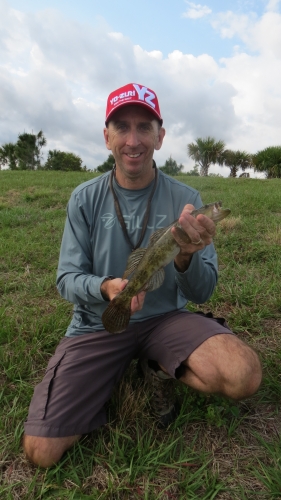
Bigmouth Sleepers will readily attack minnow type jerkbaits, lipless crankbaits, small swimbaits and flukes fished in the middle of the water column. Keep your color selection simple by matching the forage of the area that you are fishing. Basic chrome, silver and white are often good choices as they will imitate small finger mullet or minnows. Although bigmouth sleepers have a large mouth keeping your bait choice to under 4” will increase the chance of a good hookup. Yo-Zuri’s 3D line of jerkbaits are excellent producers and come in a 3 ½” size that easily imitate a finger mullet. Cast your lure in and around the mouth of spillways and areas with current making sure to retrieve your bait in the direction of the current in a natural manner. Slow and steady is the key as bigmouth sleepers are ambush predators that won’t swim very far to chase down a meal. Don’t be afraid to cast up tight to the bank as bigmouth sleepers will get very shallow in anticipation for an unsuspecting baitfish to drift by in the current. “I’ve caught fish right up against the rocks” exclaims Tompkins.
Live baits such as shiners, finger mullet, mud minnows and shrimp are excellent choices to fool bigmouth sleepers. As with lures, keeping the size of your baits to under 4 inches will increase the chance for a successful hookup. Freelining live baits as well as using a float are affective techniques. Bigmouth sleepers generally run in the 1 to 2 lb. range however, a 20 to 30 lb. Yo-Zuri Top Knot fluorocarbon leader is recommended in case you encounter a larger brackish water species. “I always use a leader because you never know when you might hook into a snook, tarpon or a big gar!” explains Tompkins. “I’ve caught bass, snook, redfish, tarpon, gar, speckled perch and mangrove snapper all in the same areas with the bigmouth sleeper” boasts Tompkins.
Bigmouth sleepers can be targeted year-round with the best months occurring during the warmer periods of spring summer and fall. Focus on smaller brackish water spillways in central and south Florida with minimal but steady current. Avoid large spillways with fast and rolling current as bigmouth sleepers prefer quiet areas to lay on the bottom while awaiting an easy meal to drift by in the mild current. To scout out a prospective spillway, make sure that spillway flows from freshwater into salt or brackish water. The presence of freshwater species of fish at the mouth of the spillway such as bass, bluegill or tilapia are a good indication that bigmouth sleepers may be present!
The FWC designates the bigmouth sleeper as a “restricted species of marine life” along with other species of ornamental tropical fish. Many fishermen targeting bigmouth sleepers value them as a rare and unique fish and immediately release any fish back into the water. There is no size limit with a daily bag limit of no more than 5 of any one “restricted species of marine life”, which includes the bigmouth sleeper. Any fish harvested (kept) must be maintained alive as part of FWC’s “restricted species of marine life” requirement. The FWC does not maintain a state record for the bigmouth sleeper, however the International Game Fish Association has documented a world record of 4 lbs. 6 oz. caught in 2001 in Costa Rica.
Bucket list anglers may want to add the bigmouth sleeper to their list of unique Florida catches such as with the Suwanee bass, clown knifefish, peacock bass and the bullseye snakehead. Due to the bigmouth sleeper’s specific habitat and range in Florida, they are indeed an uncommon species and the envy of any angler desiring on a rare catch!
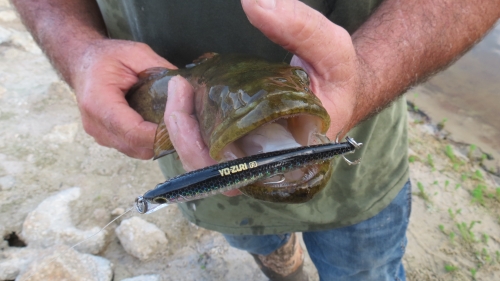
Side Bar
Targeting Bigmouth Sleepers:
• Focus on warm months when bigmouth sleepers are more active.
• Locate brackish water spillways in central and south Florida.
• Favor small spillways with mild current.
• Avoid large spillways with fast or rolling current.
• Artificial lures used should be less than 4 inches in length to ensure a solid hookset.
• Try jerkbaits, lipless crankbaits, small swimbaits or flukes fished in the middle of the water column.
• Live bait can be excellent for bigmouth sleepers. Try finger mullet or shiners freelined or fished under a cork.
• Always use a 20 to 30 lb. fluorocarbon leader in case of snook or other toothy fish.
• Once a bigmouth sleeper is landed, there is the likelihood that there are others present. Keep casting!
• Practice catch, photograph and release!
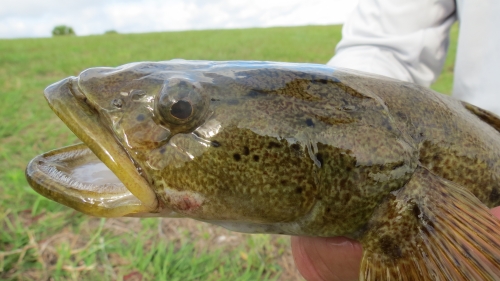
Beginners Guide to Plug Fishing the Cape Cod Canal
 There is no better place in the world for consistently catching trophy sized Striped Bass from land than the Cape Cod Canal. The six-mile-long, man-made canal, is a land-based fisherman’s dream. There are multiple points of access, a sidewalk on each side of the canal for walking or biking and most important, boats are not allowed to fish in the canal! If you’ve never been to the canal before here are some tips to get you ready for your first trip.
There is no better place in the world for consistently catching trophy sized Striped Bass from land than the Cape Cod Canal. The six-mile-long, man-made canal, is a land-based fisherman’s dream. There are multiple points of access, a sidewalk on each side of the canal for walking or biking and most important, boats are not allowed to fish in the canal! If you’ve never been to the canal before here are some tips to get you ready for your first trip.
Timing
The key timeframe is the end of May through early September. The fish migrate from the south and quality size fish will arrive sometime around the end of May. Some fish will push through and continue north, while others will stay through the summer, taking advantage of the bait that stays in the canal. At the end of August and through early September there is a push of fish heading south, “when the cows come home”. If you are making a special trip to the canal the key is to line up your trip with the “breaking tides” during June, July or August. The breaking tides are negative (or double negative) low tides that occur at or around sunrise. These tides trap bait in the canal and offer Stripers the ability to ambush prey, particularly on the surface. The best tide chart to use is the Army Core tide chart – https://www.nae.usace.army.mil/Portals/74/docs/Recreation/CCC/Brochures/2020TideTables.pdf . The negative tides are marked with a * or ** for double negative. The sun rises in the summer sometime around 4:30-5am so plan on being there early to get a spot in the dark.
Planning your trip
Once you have identified the dates for your trip there are a few key things to book. First would be a location to stay. There are several local hotels and campgrounds in the area but my first choice is an Airbnb rental. If your lucky you can find a rental directly on the canal for an affordable price. One addition that I would highly recommend is renting a bicycle for riding the path along the canal. There are a couple local companies that rent bikes with rod holders and baskets for your gear, specifically for fishing the canal. Having a bike is key for maximizing your chances of being in the right place at the right time. Be sure to grab a rental vehicle large enough to carry your fishing gear and bicycles. A lot of the guys fishing the canal wear waders so they can wade out to cast and to make landing big easier. I personally prefer water proof boots and comfortable pants over the waders. That combination makes riding the bike much easier. Whatever your choice, make sure that you have water proof footwear. You can choose to wear spikes on your boots but I haven’t found that to be necessary for most areas on the canal, although you do need to be careful with your footing especially at low tide.

Tackle
The canal is a long-distance casting game and your gear needs to reflect that. I bring two rods (both 2 piece) for the canal:
1. 10-1/2 ft, 20-40lb class spinning rod, 1-4oz lures – This is the rod I use to throw swimming plugs or smaller topwaters.
2. 11ft, 30-60lb class spinning rod, 4-10oz lures – This is the rod I use to throw heavy swimbaits, heavy jigs and large topwaters.
On both rods I fish either a 200 or 250 size Van Staal but you can fish any comparable size spinning reel. The key is to not go overboard on line and leader size. On both rods I fish:
40lb Yo-Zuri SuperBraid – http://yo-zuri.com/category/superbraid/
40LB TopKnot Fluorocarbon – http://yo-zuri.com/category/topknot/
If you are doing heavy jigging you can step up your leader size but in almost all cases 40lb is fine. If you want extra distance on casting you can drop your braid down to 30lb but for me 40lb is perfect. There are a lot of people fishing the canal and therefore I like to us white braid because I can see it easily and keep track of where my line is compared to the other anglers. On my rods I fish a 75lb prime snap by Spro, that allows me to quickly switch lures without having to re-tie.
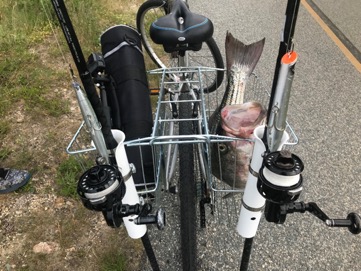
Lures
Lures for the canal can be broke down into three categories: Topwaters, swimming plugs and heavy jigs/swimbaits. I will be the first to say, I am not dialed in to the jig/swimbait bite and they are most effect after dark. I focus my attention on topwaters and swimming plugs. The key with any lure for the canal is distance. There are a couple key lures by Yo-Zuri that fit this fishery:
Topwaters
a. Yo-Zuri Surface Cruiser (6-1/2”) – http://www.yo-zuri.com/products/surface-cruiser-floating/
b. Yo-Zuri Mag Popper (5-1/4”) – http://www.yo-zuri.com/products/mag-popper/
Swimming Plugs
a. Yo-Zuri Hydro Minnow Long Cast (6-3/4”) – http://www.yo-zuri.com/products/hydro-minnow-lc/
b. Yo-Zuri Mag Darter (6-1/2”) – http://www.yo-zuri.com/products/mag-darter/
c. Yo-Zuri 3D Inshore Twitch Bait (5-1/4”) – http://www.yo-zuri.com/products/3d-inshore-twitchbait/
The Surface Cruiser has enough weight (2-1/2oz) and the stream lined shape to cast long distances but still floats, unlike many of the other topwaters thrown on the canal. That allows you to vary your retrieve while the other pencil poppers can only be fished fast or they sink. The Mag Popper, Mag Darter and Hydro Minnow LC have weight transfer systems to offer even greater casting distance, especially into the wind. That can make the difference between hooking up or just watching fish break outside your range. All of these plugs have 3X or 4X strength treble hooks and split rings that can handle bass up to 50 inches or more, even in the strong current of the canal.
The majority of the topwater lures thrown on the canal are pencil poppers, like the Surface Cruiser. However, a traditional style popper can be extremely effective as well. On my last trip I caught 20+ slot and schoolie size Stripers on the new Mag Popper. This is the best casting floating popper on the market period. It has a patented Magnetic Weight Transfer system that uses a sled that slams into the back of the bait during your cast and then locks back into place after landing. I fish the popper around slack tide and the first hour of the tide. I work it slower and more subtle for Striped Bass than I do for other species (Jacks, Tuna, Roosterfish). Letting it swing at the start of the tide, while working it slowly can be very effective. A big plus on the popper is it stays in the strike zone longer and many times you can hook up even if the fish misses the plug on the first strike.
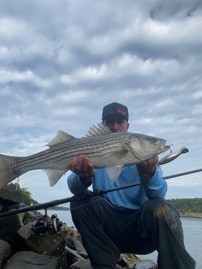
Personally, I reserve throwing topwater plugs until I see fish actively breaking on the surface. Some guys will throw them all morning but for me I put in on the secondary rod and grab it when the opportunity appears. For the most part I fish a swimming plug and 75% of time the swimming plug I throw is the Hydro Minnow LC. That plug casts very well because its stream lined, weights 1-3/4oz and has a weight transfer that keeps it from tumbling in the wind. It has the swimming action, shape and size that perfectly mirrors the tinker mackerel in the canal. It’s a plug that I can make long casts to breaking fish with or that I can catch fish up close to the rock because it stays in the water all the way back to you. I always have this plug tied on a rod when fishing the canal and I’ve caught some of my largest Stripers when they aren’t actively feeding on top.
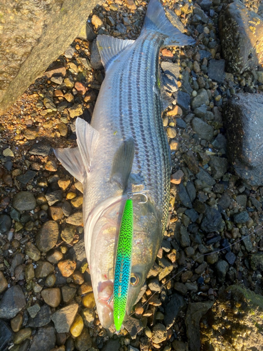
A new addition to fishing the canal for me is the Yo-Zuri 3D Inshore Twitch Bait. This is a slow sinking lipless twitch bait that can be fished with a straight retrieve or slowed down and fished with a twitch and pause retrieve. This bait has a different (deeper) profile and you can vary the retrieve to get finicky fish to eat. In this bait I tend to throw the Bone pattern or the Peanut Bunker pattern.
There are many colors that will work on the canal but the two main patterns for plugs are Green Mackerel and Bone. Mackerel are the key forage for Striped Bass in the canal. Other prey is available, including Squid, Herring and Bunker, but Mackerel is the bait that fuels this fishery. When picking colors for my plugs I make sure to have at least a couple of each plug in a mackerel pattern. In 2019 the regular Green Mackerel pattern was the hot ticket for me. In 2020 the new Wacky Mackerel pattern (combination of Green Mack and Bone) was the go-to color for the bigger fish. For topwater plugs, I will once again fish the Green Mack patterns but I would also suggest having a few in the Bone pattern and a couple in an all Yellow school bus pattern. When throwing to breaking fish having a solid color, that is easy for them to see can be important.
Strategy
Before I arrive, I research where the fish have been showing up on the canal. There are several forums, blogs and pod casts that report on the bite in the canal. I have personally had the most luck in the middle to west end of the canal. I will park at an access point close to where the fish have been and with the bike work that general area. The canal connects Buzzards Bay on the west end and Cape Cod Bay on the east end. Buzzards Bay is shallower than Cape Cod Bay and the water warms up faster. Therefore, most of the early season (May/June) fish tend to be caught on the middle to west end. One unique thing you will notice about the canal is the direction of the water and the tides are not lined up exactly. The water will change direction (from east to west or west to east) an hour before high tide and low tide. The key is to be in the right spot when the tide turns from west to east. I will typically be somewhere on the west end early in the morning and fish that location until the tide turns east towards Cape Cod Bay.
I am not a stationary fisherman. I grew up chasing fish down the beach or up and down the pier. So, when the tide turns east, I wait for a school of Striped Bass to push the mackerel through and I will jump on bike and follow them for several miles, picking away at fish as I go. I will catch a few, when they pass by, I jump on the bike and find an open spot farther east and repeat as I go. A lot of guys will won’t put in the effort to move, instead choosing to wait for the next school.
There are names for many of the famous spots along the canal and you can find a guide to that online. There are key spots like the Railroad track bridge, the radio tower and the state park on the east end that get larger crowds, but fish can be caught at any location along the canal.
Final thoughts
One of the best ways to get outfitted for EVERYTHING you need to fish the canal, including information on where the bite has been, is to go to Red Top Sporting Goods or Canal Bait & Tackle. These are well stocked stores and the employees fish the canal on a regular basis. They are a great place to pick up a two piece rod, reel, line and all the lures and terminal tackle you need. Check out these stores, including their great section of Yo-Zuri products.
Red Top Sporting Goods
www.redtopinc.com
Address: 265 Main St, Buzzards Bay, MA 02532
Phone: (508) 759-3371
Canal Bait & Tackle
www.canalbaitandtackle.com
Address: 101 Cranberry Hwy, Sagamore, MA 02561
Phone: (508) 833-2996
The last thing I will say on the canal fishery is if you do visit please pick up after yourself and follow the local fishery laws. This is a one of a kind fishery, let’s keep it great for future generations!
Sizzlin’ Summer Snap Bean Slabs
As summer temperatures heat up, slab crappies and bull bluegills can become more challenging to catch. They have often times moved on from their spring spawning grounds and can be in multiple locations in a lake as their metabolism is at its peak. The Yo-Zuri Snap bean is a great lure choice to entice these hungry bulls and slabs.
At 1” long and 1/16 oz., the Yo-Zuri Snap Bean is big enough to get the attention of big panfish, but it is small enough to still get fish to bite when they are more finicky. The Snap Bean is one of the most versatile mini hardbaits available as I have successfully used it with a bobber, casting, and trolling and drifting while fishing crappies and bluegills. This versatility is one of the most important features of the lure during the summer as it may be necessary to fish it several differ ways in the same fishing trip.
Bobber Fishing
Using a bobber can be a solid choice when crappies and bluegills are stacked in submergent grass. In this situation, I use a split shot about a foot above the lure and set the rig so that the Snap Bean nestles just above or just at the tops of grass. Using a cadence of one or two reel cranks followed by a pause can elicit strikes from fish which are deep in grass and unfishable with other setups. Patterns like the Silver Black, Perch, and Tennessee Shad are good options in grass as they emulate the minnows which often inhabit these weed scenarios. When fish are finicky or lipping and spitting out the lure, I tip it with a 1” or smaller yellow grub as that small trailer can sometimes turn reluctant biters into feeders.
Casting
Casting Yo-Zuri Snap Beans with 4 lb or 6 lb Hybrid line is preferred when fish are stationed in isolated cabbage patches. Once again, I use a split shot about a foot above the Split Bean rigged up on an ultra light rod. The key to fishing isolated cabbage patches is to get as close to the vegetation without scaring fish (20 yards or closer) so that all sides of the weeds can be fished. Working the Snap Bean painfully slow is key in this scenario as the idea is to cast the lure next to cabbage plants and let it sink slowly to the bottom. If a fish does not hit it by the time it hits the bottom, I reel up and cast again as most strikes usually occur on the fall. Pink, Black Purple, and Gold Black are all great colors as they can easily be seen by fish surging out of cabbage to eat.
Drifting/Trolling
Trolling and drifting Yo-Zuri Snap Beans can work great in shallow sand/rock (10’ of water or less) which is adjacent to weeds and when chasing suspended schools of panfish over deep water (fish 15’ deep in 30’ of water, for example). As with bobbers and casting, I usually go with a split shot a foot above the Snap Bean to help with getting the lure down to the desired depth. The Crawfish Snap Bean is my favorite pattern when chasing crappies and bluegills in sand/rock areas as this color is similar to the small crustaceans upon which they are feeding. The Perch, Silver Black, and Tennessee Shad patterns all work great when trolling or drifting for suspended panfish as they look like the minnows that big crappies and bluegills are eating.
When others give up on big slab crappies and bull bluegills in the heat of summer, the Yo-Zuri Snap Bean can put fish in your boat. Stock up on these dynamite mini hardbaits today!
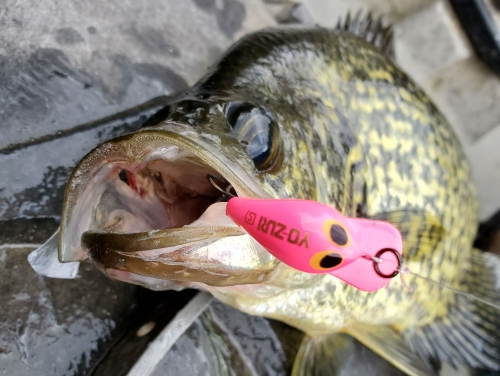
Mid-Summer Crappies & Early/Late Ice Walleye
Mid-Summer Crappies
Lure: Rattl’N Vibe
Line: Yo-Zuri 20 lb test SuperBraid
Colors: Glow, Glow Perch, Wonderbread
Location: Lilypads or grass in 4′ of water or less adjacent to a sharp drop into 10′ of water or more.
Scenario:Crappie metabolism is at its peak in mid-summer and the fish feed on bigger prey. Using a 2 1/8″, 5/8 oz. Rattl’N Vibe in the new Glow, Glow Perch, and Wonderbread patterns from 30 minutes before sunset to 15 minutes after sunset close to the edge of lilypads and/or grass can be dynamite for big slabs. Letting the lure fall to halfway down in the water column and varying the cadence with up to 4 reel crank turns followed by a pause can elicit some dynamite strikes.
Early and Late Ice Season Walleyes
Lure: Rattl’N Vibe Mini
Line: Yor-Zuri 4 lb test Ice Hybrid or TopKnot fluorocarbon
Colors: Glow, Glow Perch, Wonderbread
Location: Sand/Rock Flats in 10′ of water or less
Scenario: Early and late season ice walleyes are voracious predators as they begin to pack on weight for the upcoming winter and then for the spawn respectively. The Rattl’N Vibe Mini is a great lure choice because it can be worked aggressively for active fish, but at 1 5/8″ and 3/16 oz., it is small enough that it can be effective for more finicky eaters as well. Using it with or without live bait works great for early and late season ice walleyes.
